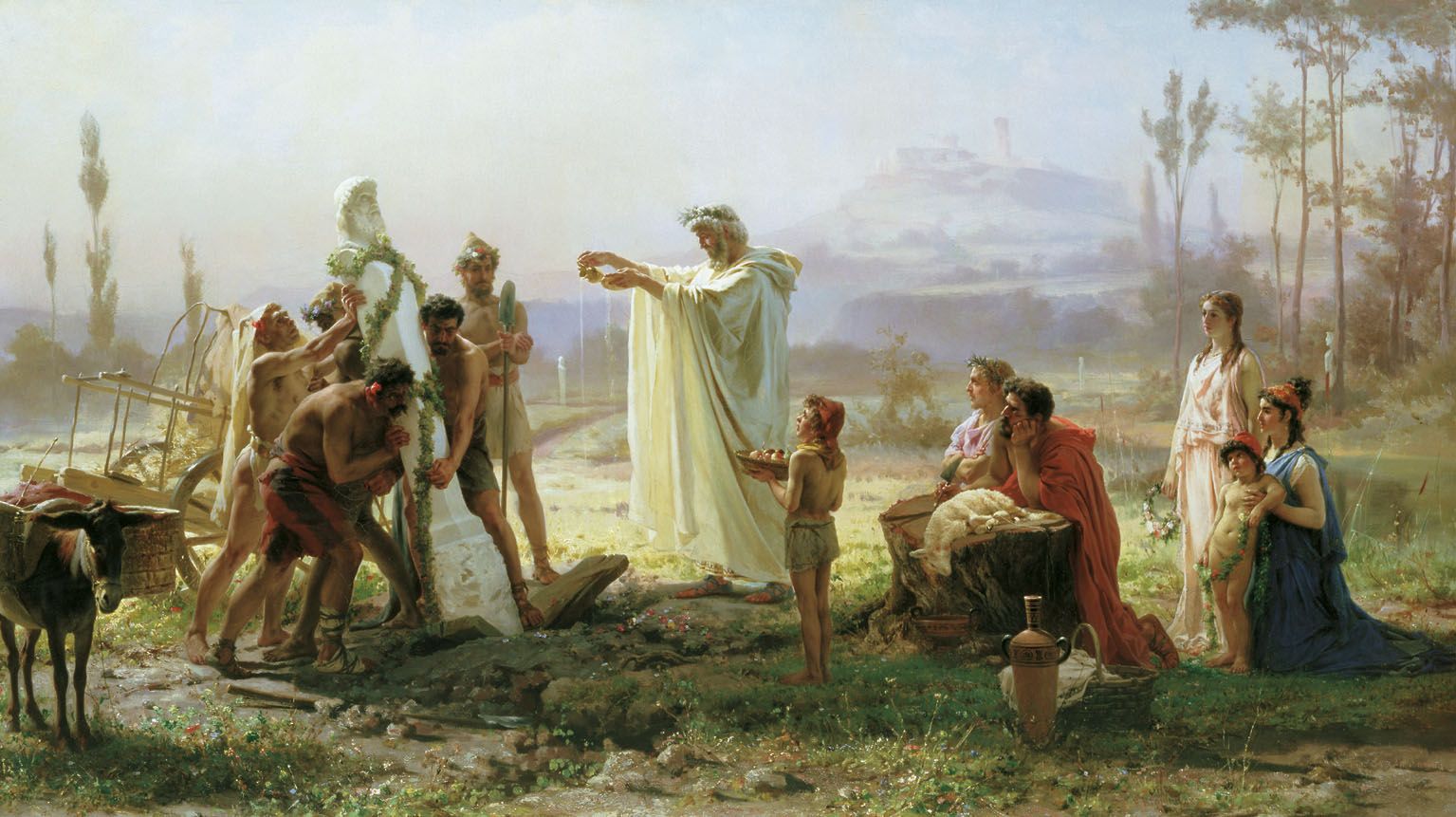
Chemistry of Compassion
Today's lecture will describe the chemistry of compassion: how compassion depends upon substances made of matter, energy, and consciousness.
First, in our meditation exercise today, we had three stages of practice.
In the beginning, we did a breathing exercise in which, with relaxation and concentration we filled our lungs and then held the breath for as long as was comfortable, imagining that the restrained breath was like an energy or a light filling the brain with light and fire. We held the breath as long as we could, and then we exhaled, sending that same light and fire into the heart in order to nourish the heart. This breathing practice is called in Sanskrit, ‘pranayama’, which in one way means, ‘to harness the wind’. But the deeper meaning is ‘to harness the force of life’. Variations of the exercise are common throughout religions, but unfortunately, in the western religions those techniques have been largely forgotten.
After that exercise, we then worked with a meditation experiment. In the first part of it, we imagined someone that we feel a very natural and spontaneous love for, in order to evoke that quality, to feel it. The instruction was to not focus on the person, but on the quality that we feel. So, as soon as the image of the person came into our imagination and we started to feel that emotion, that care for them, love for them, that feeling became the object of our concentration, that quality, and how it affects us.
Then, subsequently, in the final phase of practice, we were to imagine having that quality for everyone on the planet, a type of universal love.
Having done these exercises, did anyone here find that the first exercise, the breathing practice, changed their physical body? Did you feel more relaxed? Did you feel more serene? Did it affect you physically?
In the second exercise, when you imagined someone that you feel love for, did that affect you physically? And did that third phase of imagining humanity affect you physically?
Each of these exercises demonstrates that everything spiritual has a material component. Everything related with divinity is rooted in matter and energy. There is no exception to that.
Unfortunately, in the West, we have this concept that spirituality and religion are just theoretical, conceptual, or belief and thus has no relationship with physicality, with energy, but that is absolutely mistaken.
Love is a substance. We never think about it that way, do we? We think of love as something intangible, something elusive. We do not realize that love is a substance. We consider love to be insubstantial (without substance) because we have little experience with it.
Today’s lecture is called ‘The Chemistry of Compassion’, the second lecture in a course that we are now developing about compassion.
In modern psychology, the modern way of thinking, we differentiate compassion from love. We tend to think of compassion as pity or sympathy, and honestly we don’t consider it that important; the evidence is how little importance it has for us culturally. Our idea of love, on the other hand, is the central subject of most of our culture.
All of us were raised to have as our greatest ideal the experience of love, and the continual presence of love. Our ideal is to have love as a couple, a marriage, to have love as a parent, to have love as a child. We definitely relate all of that with physicality, with the experiences we have in our bodies, in the world. It is incontestable that our idea of love is intimately related with physicality and sensations. What do we see as the highest expression of love, and the greatest fulfillment of love? Sex. There is no question about that. That is why the center of gravity of our society is sex. Everything we ever do socially, in the world, in community, in family, rotates around sexuality. Everything we wear, everything we say, the types of jobs we pursue, the types of interests we pursue, the types of people we get to know. All the things we do are always related to, at its core, often without our awareness, sex.
We can observe this in ourselves and in the world. But what we fail to recognize is that life and sex and compassion and love are all very closely related. That is why you cannot separate sex and religion. They are essentially the same thing, even though in modern times we do not grasp that. Every scripture in the world has sexual symbolism, and there is a reason, there is a purpose, there is a very scientific cause and effect relationship between sexuality, love and compassion. And that is what we mean by the lecture topic: chemistry.
The chemistry between people is undeniable. The chemistry of sexual attraction is undeniable. It is not intellectual. It is not emotional. It is chemical. Sexual affinity is a type of chemistry. That chemistry is at the root of all living things on every level of nature. It is the chemistry that produces microbes. It is the chemistry that produces flowers. It is the chemistry that creates all the animals. It is the chemistry in the animal kingdom that causes procreation and allows those kingdoms to proliferate. And it is the same in the humanoid kingdom, amongst us. It is a chemistry between people of sexual affinity that is hidden behind with our idea of love, and the production of children and of the continuation of the race.
Sexual chemistry is the magic of love. They cannot be separated. In all the kingdoms of nature, love and sex are united. In all chemical reproduction, there is love. Beautiful flowers are expressions of sex and love. That is why we instinctively relate flowers to sex and love: because in fact they are related. So, we find love in all the kingdoms of nature, yet each creature experiences love at their level. A flower loves, and expresses love through its innate abilities. An animal also loves, and as a creature in a higher kingdom, it loves greater. Humanoids like us also love, and our love can be greater than anything a flower or animal could experience.
What we do not realize is that all those lower kingdoms (mineral, plant, animal and humanoid) are merely the foundation for the greatest expression of love, which is amongst the gods, masters, angels, buddhas. The love that a master has, that a god has, for others, is built on the same foundation, but at another level.
And that is why we have this image here of the divine mother and the Christ child. That symbol illustrates very profound facts in nature related with how gods are created, how masters emerge, how angels are born, how buddhas are born, how they rise out of life to become what they are. All of that is rooted in love, but in levels, and all of that is rooted in sex, but in levels.
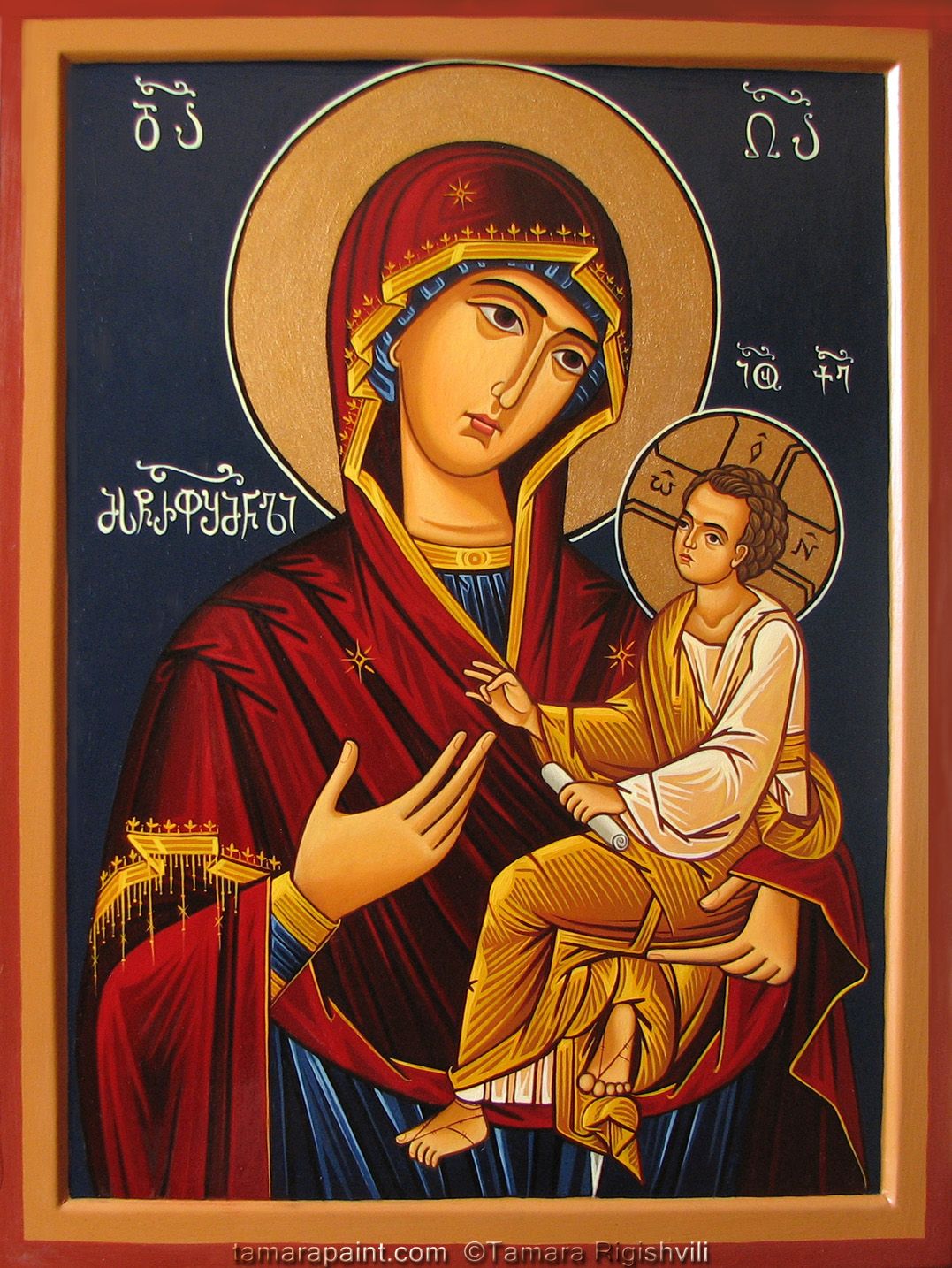
What do we find as the chief characteristic of a master, a god, a buddha? It is love, compassion. The single greatest quality that a human being can develop is compassion. It is the most powerful, the most profound quality that any living thing can develop in themselves. Compassion. It is the highest virtue of all virtues.
That is illustrated very beautifully in the life of Jesus. The life story of Jesus that we discuss these days as the tradition of Christianity is a perfect embodiment of compassion in action. Even when he was being tortured, he responded to his torturers with love, with compassion, with understanding. And in that, demonstrated that most profound virtue: love, compassion, the highest possible virtue that any of us can experience, that we can develop.
Compassion is contrasted by the most deadly vice, which is lust. This is what we discussed in the first lecture of this course. Compassion and lust are opposites. However, they are the same energy, just polarized. You can understand this by observing other polarities: light and dark, heat and cold. Each range of qualities is simply a polarization of one thing. Compassion and lust depend on the exact same quality of nature, but polarized.
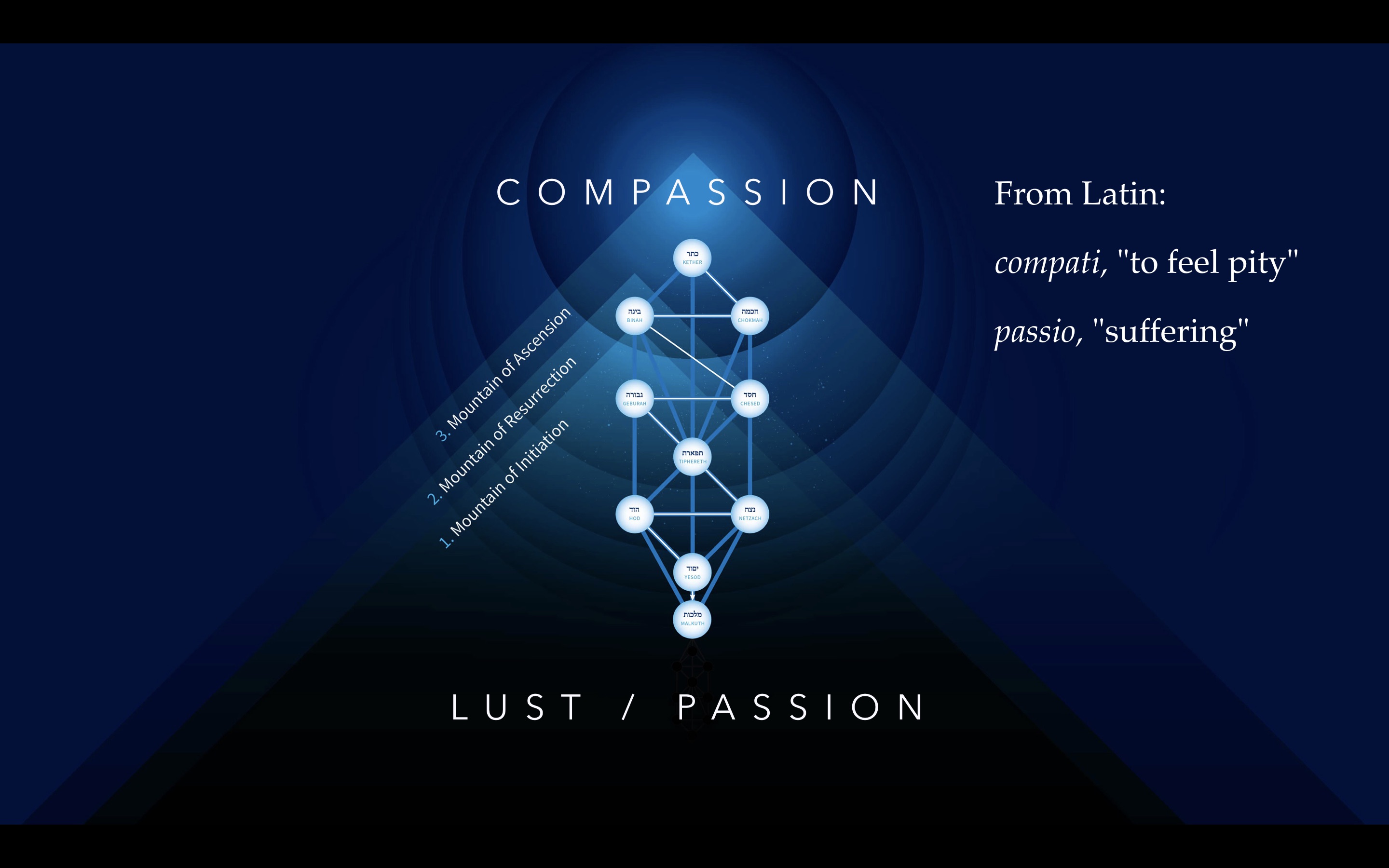
Compassion is the substance of divinity, liberated and active. And that is why it is the greatest quality amongst all the angels and buddhas, whatever you want to call perfect human beings. The thing that unifies them all is profound compassion. In Greek we call that Eros, Christ, or Chrestos. Such words simply indicate the universal nature of divinity, which is love as sacrifice for others. So, we can call that in English, compassion. And that is contrasted by its opposite which is lust, passion.
It is interesting to look at the etymology of these words, to realize how mistaken we are about ‘passion’ and ‘compassion’.
Compassion: from Latin:
- compati, "to feel pity"
- passio, "suffering"
Compassion in English comes from the Latin ‘compati’ and ‘passio’, which means ‘to feel pity for suffering, to feel empathy for suffering, to feel love for those who suffer’. And that is the quality that the gods have, angels, buddhas, masters. They feel love for us because we suffer. But that is not just pity that looks down upon those below us. It is not just ‘Oh, poor you. Look how you suffer’. That is not what that is. Compassion is something far more profound. In the whole of this course that we are going to be giving is about helping us to grasp the profundity of compassion. It is far beyond our modern concept.
Compassion, or to feel empathy for suffering, contains this word from Latin ‘passio’, which is the root of our word ‘passion’ and that word literally means ‘suffering’.
“Latin passionem (nominative passio) "suffering, enduring," from past participle stem of Latin pati "to endure, undergo, experience," a word of uncertain origin.”
Now, in modern times we use this word ‘passion’ as a virtue. We say ‘You should pursue your passion. You should live your passion. You should be passionate,’ not realizing that we are wishing each other to suffer. Passio means “to suffer.” That is the root of the word. To suffer.
The word passion originally related with the suffering of anyone, for example in the passion of Christ, but it became mixed with the concept of lust or sexual suffering.
Nowadays, we do not see lust as suffering. We see lust as normal, even as a virtue. Society very much indulges in, embraces, and protects lust, and sees it as something that can be indulged in and enjoyed without any consequence. We do not realize that is a deep and profound mistake. Lust is a profound form of suffering. It is the original sin of all the scriptures in the world, and yet we live with it on a daily basis not recognizing it for what it is. We are like someone who has lived their whole life in a dungeon, and does not realize that their daily life is actually terribly conditioned and limited.
The Origin of Suffering
Lust is the axis of the wheel, the very profound fuel that starts and perpetuates suffering.
This is obvious in the Bible, such as in the story of Adam and Eve. Think about it: a naked man and a naked woman in a beautiful garden are tempted to eat of a fruit. Obviously, this is a sexual story. But what humanity has never grasped, because it was always veiled, is the meaning, because the Christians threw all that out a long time ago. And in the Jewish tradition, that knowledge has been veiled, hidden, limited, protected. We are going to explain it to you.
This story of Adam and Eve eating of that forbidden fruit, it explains how humanity, in a primordial state of innocence, was tempted to experience something that had been previously denied to them. And by succumbing to temptation and indulging in that experience, they discovered pain. They discovered suffering. So, desire led to suffering.
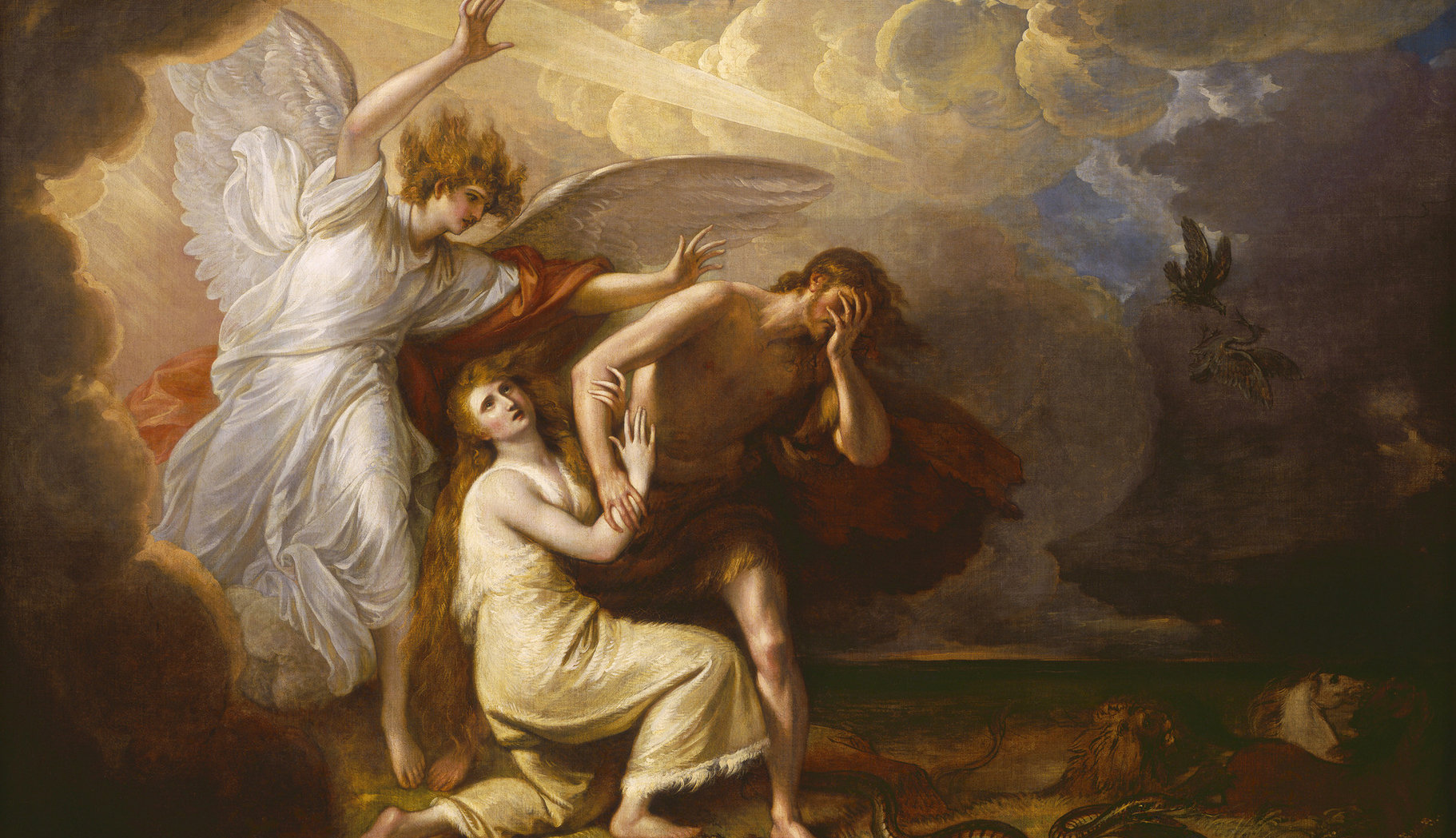
That is exactly the basis of Hinduism and Buddhism.
The Buddha taught four truths.
- There is suffering
- The cause of suffering is desire
- There is a remedy for suffering
- The remedy is the path that liberates the consciousness from desire
Many modern Buddhists study this but fail to realize how to live it, because many modern Buddhists like to stay at the surface of things and do not dive into the deep meanings that are in these four truths. Specifically, they do not want to eliminate their lust.
If you study the world religions and gather them together and see their common themes and teachings, you can start to recognize that all truth emerges from reality, and that all of these religions are pointing at something scientific, something true, something real, something you can confirm for yourself: how suffering emerges and how to overcome it.
To understand how to do that we need to grasp that everything that exists on every level is comprised of three things:
- consciousness
- matter
- energy
There are no exceptions to this. Even what we call “God” cannot function without these three, yet these three are not exclusively physical. The heavens and hells are forms of matter and energy that are not physical.
We, ourselves and our physical bodies, have physical matter. the body itself. And that body, the matter of it, the physicality of it, is able to be alive because there is energy in it. So, energy is intimate with our experience of being here and now. But our perception of that and the recognition of being alive is consciousness. So, all of us are experiencing consciousness, energy, and matter, right now.
When we practiced that meditation technique today, when we were evoking the image of someone we love, you felt emotion. You felt movement. A pressure. A quality in your heart, physically. When you feel love for someone, do you not feel it in your heart? In your chest? Does it not feel like a fire? Sometimes it is painful. Love can be so strong that it hurts. Anyone felt that? That experience proves that love is not just a concept, it is a substance. You feel it physically, which means that love also has matter and energy and consciousness. And, since we know that love and lust are the same substance but polarized, then lust is also substance.
When we indulge lustfully in the sexual act, we experience the consciousness, energy and matter of lust. When we become angry with someone, we also experience anger physically in matter and energy and consciousness. All psychological phenomena have a material element, an energetic aspect, and they have a conscious aspect.
Physically, in our physical bodies, we feel the reverberations or vibrations of those material aspects.
For instance, anger emerges in you as thoughts, feelings, and as impulses to act physically. But all of that anger that you experience, moving you in your thoughts and feelings and in your body, is just the echo or reverberation of its source, which is not physical matter or energy, it is psychological matter and energy. In other words, the substance of anger is not physical.
That word, ‘psychological’ is from ‘psyche-logos’. Psyche is the soul. Psyche is non-physical. It is where we have our thoughts and feelings and impulses. We experience them through the body, but their origin is not the body. Thoughts, feelings, and impulses also have matter and energy, but not physically.
You can more directly perceive the consciousness, energy and matter of lust or anger or love when you have a dream. When you are in your dream world, you do not realize you are dreaming, but you are there very much engaged with matter, energy and consciousness. It is just different. You are talking to a banana that has a face and that is telling you some profound story and you are laughing hysterically, not realizing that you are in a dream talking to a banana. Everyone has experiences like that. Maybe not a banana, but maybe you talked to a monkey or maybe you talked to an elephant.
Dreams are experiences of your own more subtle levels of nature, and they are illustrated in this image we call the Tree of Life.
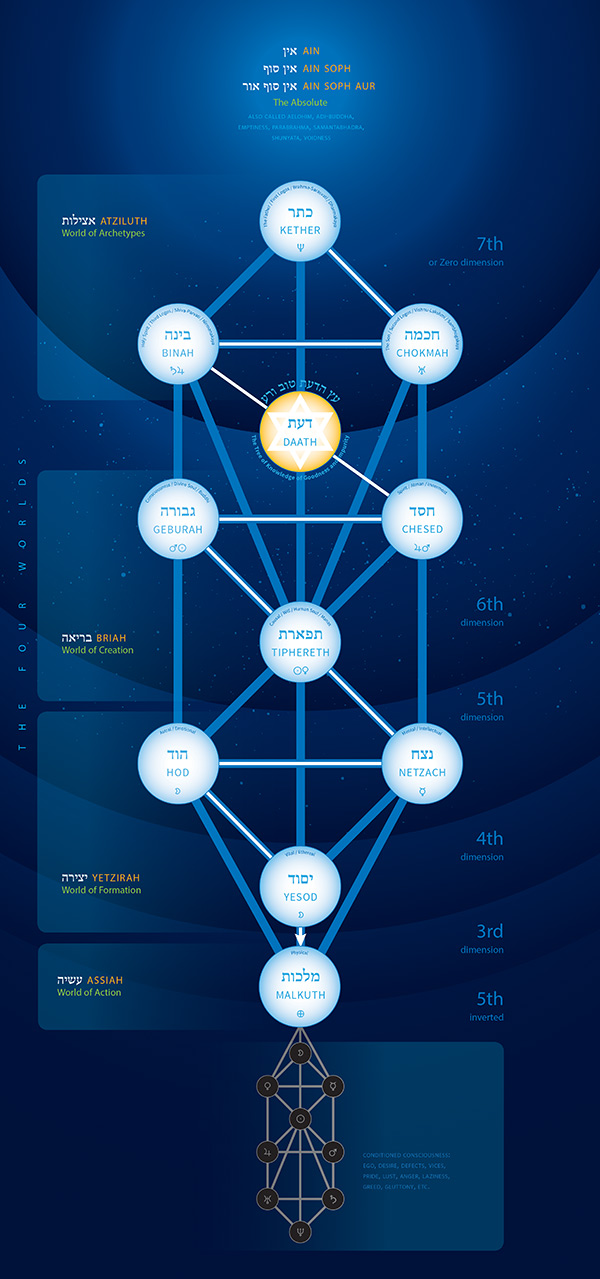
The physical body is the lowest sphere, Malkuth. Within it are more subtle levels. So, when you sleep physically, your consciousness goes out of the body and experiences the world of dreams as though it is still in the physical body, but it is not the physical body, it is in the emotional body (Hod). And in that emotional body, you interact with the qualities in your mind: anger, lust, fear. In our dreams, we perceive those qualities in various forms: they appear to be people, creatures. They have matter, energy and consciousness.
Simply put, your psychological characteristics have matter and energy in more subtle levels of nature. We can call that subconsciousness, because it is below (sub) our awareness. In those levels, anger, envy, lust, etc. have form: bodies, matter, that have energy (activity), and consciousness trapped within them: our consciousness. That is why we suffer. To liberate ourselves from suffering, we have to destroy those forms. Yet, because they are not physical, while we are in our physical bodies we cannot observe those qualities directly; we can only observe their effects upon us. To see them directly, we have to open our eyes in those subtle worlds. That is why we learn to meditate. That is why we learn to get out of the physical body.
Understanding this, we can then understand that all qualities, whether positive or negative, have corresponding matter, energy, and consciousness, each in their own level. Obviously, vices reside in the hell realms (subconsciousness), while virtues reside in the heavenly realms (nirvanas). Compassion is the highest of them all.
When we talk about the superior beings having virtues, those are not just theories. They are not just beliefs. Virtues have matter. Virtues have material structures in the same way that our lust and anger do, but with the difference that the qualities that cause suffering reside in what we call the hell realms or the subconsciousness which is the shadow of the Tree of Life. It is the reflection of the Tree in darkness.
The positive qualities, the virtues, are in the light, what we can call heavens. Virtues are not just ideas. They have substance. They have structure. They have an atomic value. They exist as functional elements in nature.
I know that for our mind this can seem bizarre, because we tend to think of psychology as something that does not have a substance, but everything in nature has a substance in its level. That is what the Tree of Life shows us. God itself depends on matter, but at that level. The Tree of Life shows matter, but at many levels of manifestation.
Physically, we experience the third dimension in the physical world, but all of the internal dimensions have corresponding degrees of matter in that dimension. And that is what you experience in the world of dreams. When you dream, you are in the fifth dimension. The laws are different. You can fly. Your body can change shape. You can stretch it out. You can shrink it. You can pass through objects. There are different laws there. The same is true in the fourth dimension, the fifth, the sixth and the seventh. Each has different laws, but in each level there is still matter, energy, and consciousness, they are just increasingly subtle the higher you go. All of these dimensions are here and now, interpenetrating each other, we simply cannot see it because of our conditioning. The other dimensions are not somewhere else: we ourselves have all these dimensions to ourselves, right now, we are just ignorant of it.
So, the synthesis of that, if it seems very confusing, is simple. Everything has substance. The key to spiritual development is to know how to work with substance. And that is why one of the great traditions that conveyed these teachings through history, is called alchemy. Have you heard of that? Translated directly, that term, ‘Al-Kimia’ means ‘The chemistry of God’. And it is not about theories and beliefs. It is about chemistry, but not physical chemistry.
Bodhichitta
This word, ‘compassion’ that we have been discussing, has a technical term in Sanskrit, and that word is ‘bodhichitta’. This term, bodhichitta, is the very foundation of Buddhism. And it has other translations in other traditions, but I want to focus on this term, bodhichitta, from Sanskrit because it is so well explained in Buddhism. When you understand how it is explained in Buddhism, you can understand it in any religion, because all religions reflect the same truth. They just all do it in a slightly different way.
So, in Buddhism compassion is studied as this term, bodhichitta. That word is very difficult to translate directly into English.
The first part is bodhi, generally translated to mean ‘wisdom’. Everyone who has heard of Buddhism knows that the Buddha gained enlightenment under the bodhi tree. What people do not realize is that the bodhi tree is a ficus, a fig tree, which is the same symbol as Adam and Eve, when they used fig leaves to cover themselves.
On the Tree of Life, the second sephirah is Chokmah, which is Hebrew for “wisdom.” Immediately below that sephirah is Chesed (“mercy”), also called Gedulah (“love”), which symbolizes our inner Buddha, represented in the Bible by Abraham. Our inner Buddha gains enlightenment under “wisdom” (Chokmah) on the Tree of Life. This is clear evidence that Buddhism and Judaism come from the same source.
The second part of bodhichitta is ‘chitta’ which has many implications. Usually when it is translated into English, it is as ‘mind’. Unfortunately, in the west, we think of mind as intellect. But that is not what chitta indicates. Here are some literal meanings for chitta:
"heart, wish, thought, ninth mansion, thinking, aim, intention, reason, observing, imagining, intelligence, mind, reflecting, attending, memory, knowledge."
‘Chitta’ is comparable to ‘psyche’ from Greek. Simply put, chitta is ‘mind-heart’. It is more broad than just intellect. It is a type of perception and cognition. It is a way of understanding. Chitta is a way of comprehending, a way of perception and understanding.
So, when you think about it this way, although ‘bodhichitta’ is usually translated as ‘Awakening mind’ or ‘Wisdom Mind’, really it means, ‘a way of perceiving with wisdom’. A way of understanding the truth.
Traditionally, religions have three levels of instruction. Today, in most places, this has been lost.
- Public, introductory. Lay persons, householders.
- Private, for those who have mastered the introductory level. Usually Elders.
- Secret, for those who have mastered the private level. Usually priests, priestesses.
Therefore, each aspect of religion has three levels of understanding. Bodhichitta definitely has three levels of understanding.
Bodhichitta as Compassion
Most modern Buddhists talk about bodhichitta in exactly the same way we talk about love or compassion, as a quality or attitude, something insubstantial, like any concept or belief. They consider bodhichitta as an attitude of compassion for others. On the most basic level, that is true. Basic Buddhism, which is called Sutrayana, or introductory Buddhism, talks about bodhichitta as the altruistic intention to achieve enlightenment for the benefit of all beings. That is what compassion means at the basic level of every religion. It means you see the suffering of people and you want to help them. That is the basis of most spiritual pursuits in the world. All religions encourage us to serve others, to love others. This is what Jesus explained as one of the greatest commandments. First, to love God and yourself, and also to love your neighbor as you do your own god.
Compassion is basic. We need that, of course. But that is not the whole meaning of bodhichitta. It goes far deeper.
Bodhichitta as Perception
When you study the greater vehicle (Mahayana), which corresponds to the private level of instruction (requiring initiation and private instructions), bodhichitta means an elevated state of awareness which directly perceives emptiness.
The Tree of Life reflects everything that we are, spiritually, psychologically, and physically. The same structure illustrates what we mirror, which is the universe itself. So, in all the levels of nature, there are many creatures, many beings who live and suffer and die. Physically, in the physical world, we know about us, we know about all the animals and the plants and we feel a great deal of concern for all the suffering amongst the humanoids like us and amongst the animals. Some of us might even feel compassion for the plants. Some of us might even feel compassion for the suffering in the lower kingdoms. But this physical realm is just a sliver, a fraction of what actually exists in the universe. Because there are many worlds that are in a more dense layer of nature that we call the hell realms that are filled with suffering creatures, especially on this planet.
The hell realms are filled with suffering creatures. But in addition to that, in the heavenly realms, there is also suffering. It is just a different type of suffering. That is why in Buddhism the Tree of Life is illustrated as what is called the Bhavachakra, which people call the Wheel of Life, and it shows six kingdoms through which beings migrate and suffer repeatedly. At the top are the gods and at the bottom are the demons, and between are all the animals and human beings. All of us just cycle around and around, over and over, always suffering.

In modern times, we do not think of gods as suffering, but that has always been part of mythology. All religions and myths relate wars between the gods, and how angels or gods fall. Suffering happens in the heavens through envy, greed and pride.
What does this have to do with bodhichitta?
Everything that exists emerged out of the Absolute, the emptiness, the profundity of divinity that is not yet. That profound abstract space is a pure potentiality, and in that there is no suffering. There is only a type of profound unity of potential and bliss.
“The Absolute is life free in its motion. It is the supreme reality, the abstract space that only expresses itself as absolute, abstract motion, happiness without limits, complete omniscience. The Absolute is uncreated light and perfect plenitude, absolute happiness, life free in its motion, life without condi- tions, without limits. We have to terminate the process of the “I” in order to absolutely be…
“The “I” of angels, archangels, seraphim, potencies, virtues, thrones, and hierarchies of different splendors always has the innocence characteristic of children full of beauty. That divine “I” covets degrees, initiations, powers, divine titles, nirvanic majesties, and divine lordships. This divine “I” is the same human “I,” yet completely refined.
“Personality, individuality, and the “I” are the hard chains that bind us to the hard rock of suffering and bitterness. Gods and humans are submitted to the suffering of conditioned life.
“Notwithstanding, in the Absolute we go beyond karma and the gods, beyond the law. The mind and the individual consciousness are only good for mortifying our lives. In the Absolute we do not have an individual mind or individual consciousness; there, we are the unconditioned, free, and absolutely happy Being. The Absolute is life free in its movement, without conditions, limitless, without the mortifying fear of the law, life beyond spirit and matter, beyond karma and suffering, beyond thought, word, and action, beyond silence and sound, beyond forms. The Absolute is abstract, absolute space, abstract absolute movement, absolute freedom, without conditions, without restrictions: absolute omniscience and absolute happiness.
“We have to cease the process of the “I” in order to enter into the Absolute. The human “I” must enter into the house of the dead. It must go to the common grave of astral rubbish. The “I” must be disintegrated in the Abyss in order for the Being, full of majesty and power, to be born.” —Samael Aun Weor, The Major Mysteries
This quote fully demonstrates the bodhichitta of Samael Aun Weor: his compassion is founded on an understanding of the Absolute, the only source of true happiness.
When the Absolute first manifests into existence, it emerges as an absolute purity, a light, that in Hebrew is called, ‘Ain Soph’, which means ‘limitless light’. The same symbolism is found in Buddhism: Buddhist consider the first emanation as ‘Amitabha’, which means “limitless light.” That limitless light is compassion. It is love. It is the light of divinity. It is cognizance that as soon as it emerges into existence sees all of the suffering beings and wants to help them. It is the impulse that brings divinity to manifestation. It is love, compassion. The ancient Greeks called it Eros, Phanes, or Protogonos.
That love, that light, is the first thing that comes out of that emptiness, so it is a very profound thing to understand.
To have compassion for suffering beings is good. But that compassion becomes truly profound when you understand the emptiness, the Absolute. And the reason is simple: in all the manifested levels, whether amongst the gods, the human beings or the demons, no creature sees reality. Instead, each creature is perceiving through their desires. And because they are perceiving through their desires, they do not realize that their perception is the origin of their own suffering. That is why everyone is suffering. Because we do not see reality. Reality is the Absolute that gives rise to all of this.
So, the greatest masters, the greatest buddhas, the greatest prophets, are the ones that have seen reality and understood that truth. And that is why, having entered the highest level of manifested existence and experienced the reality of true happiness, our of compassion they come back in order to teach us: that compassion is the highest, love is the highest, understanding the emptiness, the nature of divinity is the highest. And all of that is one thing. It is about learning to see the truth, to see that desire is an illusion and it is the basis of all pain.
Bodhichitta as Substance
Everything is rooted in substance. Everything is rooted in matter, energy and consciousness. So, that type of perception, which in Sanskrit is called ‘Prajna’, is also rooted in substance. It cannot happen without substance: matter, energy and consciousness.
All of the Buddhists throughout history who worked through the practical teachings of the Sutrayana and the Mahayana levels (which are the most common forms of Buddhism in the world), have sought to understand this. The few who truly understood it — and proved it — could enter the third level of the Buddhist teachings, which is called ‘Tantrayana’. There they learned that bodhichitta, the substance of it, is the sexual energy itself. This is why priests, priestesses, monks and nuns are told ‘Do not waste your sexual energy’. That is why. The sexual energy is the substance of bodhichitta.
When the sexual energy is conserved in the body, it is the force of creation. It is the force of life itself. It is the most profound power that we have in us physically and spiritually. When that energy is conserved, it can be transformed. It can be transmuted and the resulting substance changes us. Instead of creating a birth physically, it creates a birth spiritually. This is explained in every religion in the world, in symbolism.
In Buddhist Tantra, though, it is explained directly.
“The ‘relative jasmine-flower-like,’ which is the seminal essence or sexual energy, is the embodiment of bliss [Eden], the ultimate [the Absolute].” — Hevajra Tantra
“Do not allow the movement [loss] of bodhichitta... ...not to lose the seminal essence [through orgasm] serves as the cause for all powerful attainments... Always maintain the ethics of not emitting [the seminal essence].’—Chakrasamvara of Fundamental Tantra.
These quotes are just two small, clear examples of many that are written throughout the Tantras, which are the most profound and significant scriptures of Buddhism. Throughout history, they were never made publicly available. Nowadays you can read them.
This first quote uses this symbol, ‘jasmine-flower-like', which is a way that they veiled the sexual energy. It says, ‘It is the embodiment of bliss, the ultimate.’ We can understand that by looking at the Tree of Life. Everything that exists condenses in nature from the absolute, divinity, the unmanifested level of existence. That emerges as a light, which in religions is always symbolized as a ray, as a lightning bolt, or as the energy of Christ itself, like Apollo and all the solar divinities from all the different traditions. They always use light or the Sun as their symbol. Jesus was not the first one to be called “the light of the world.” This was also Apollo and Ra of the Egyptians, etcetera. That light descends into all the levels of nature.
So, let us examine that within ourselves. What is the ultimate synthesis of you? You live your life, you eat, you drink, you breathe, you take in impressions. But everything about you, your entire history from every single ancestor you ever had for millions of years and everything you have ever thought or felt or did is all synthesized in your sexual seed. Everything. Your entire code of your entire history and everything about you psychologically and spiritual is boiled down into your sexual energy. And you know that is true because if you have a child It will mirror you. It will look like you. It will talk like you. It will do things like you because it is a mirror of you.
That shows you this: the sexual energy in us, which on the Tree of Life is related with Yesod, is the embodiment of everything. The ray of light that creates life is synthesized in us every single day in our sexual glands. That is why it is so important to preserve it if you want spiritual development. That is why monks and nuns and priests and priestesses in every religion in the world are told, ‘Do not waste your sexual energy’. Save it. All serious practitioners practice chastity, brahmacharya. It is the rule, because that energy is the basis of spiritual development.
“If practitioners transgress pledges and do not restore them, the transgressions become the root cause for their fall into the hell of Unceasing Torture or another hell; thus they are called root downfalls. The fourteen root downfalls are explained as follows…. (5) To lose the jasmine-flower-like bodhichitta means to emit [through orgasm] the seminal essence, the support [for bliss].” –Jamgön Kongtrul, Treasury of Knowledge
This scripture is very clearly saying that sexual energy is the cause of all suffering, while sexual energy is the cause for all blissfulness.
If you want genuine happiness, which here is called bliss (in Hebrew: “Eden”), you find that in the heavenly worlds above. That is called Nirvana in Sanskrit. Nirvana means “cessation.” It does not mean ‘heaven’. The word ‘Nirvana’ literally means ‘cessation, ending’. And what is it ending? Its opposite, which is Samsara. ‘Samsara’ means ‘to repeat, to circle’, which is what we do. Repeating our suffering. Repeating our stupidities. Repeating our mistakes over and over. Repeating the mistakes of our parents and our grandparents. Repeating the mistakes of our friends and our society and our culture. Repeating and repeating. Always suffering because we are always chasing desire not realizing that that is the basis of all pain.
When you renounce desire, you conserve the sexual energy. You begin to work with an energy, a force of life that changes everything. You can cut through that circling and experience the cessation of it, which is blissfulness, happiness, contentment, no longer chasing pride and lust and envy, but instead pursuing your full development. Happiness. Compassion. Love. All the virtues that you find depicted on the Tree of Life.
So, this Tantric teaching is simply a reflection of chemistry. But to understand that, you have to study your physicality. You have to study the endocrine system and how it works and why it is in the state it is in now.
Chemistry
The sexual energy in Kabbalah, on the Tree of Life, is related with the Sephiroth called ‘Yesod’. If you put the Tree of Life over your body, Yesod sits directly over your sexual glands.
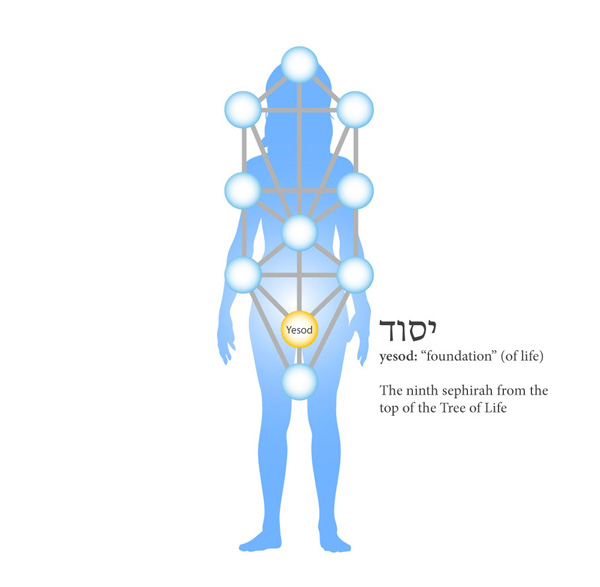
That word, ‘Yesod’, in Hebrew means ‘foundation’. It is obvious that the sexual glands are the foundation of life. If your sexual glands do not work, you cannot procreate. It is just science. It is just nature. What people do not realize is that spiritual life is also created by the sexual glands. That is why the Bible says that someone who is damaged in their sexual glands cannot enter the kingdom of Heaven.
“He that is wounded in the stones [testicles], or hath his privy member cut off, shall not enter into the congregation of the LORD.” —Deuteronomy 23:1
The sexual energy is bodhichitta, the “living waters” described by Jesus, which open the door to heaven, to liberation from suffering. That is why sexual energy is the foundation of life both physically and spiritually.
When we study the endocrine system, we see that there is a very sophisticated and profound chemistry that happens in us all the time. In all of its actions and activities, and all the food, water and air that we are constantly ingesting, the body is constantly producing the ultimate synthesis of all of that, which it deposits in the sexual glands, every day. That energy —the synthesis of everything you are, and everything you ingest— is being made by the body automatically every day, yet we fail to realize how significant that is.
Unfortunately, we do not take spirituality very seriously. We do not take the inevitability of death very seriously. We do not take karma very seriously, so we never really investigate these matters. We waste our time, we waste our life, and we waste our sexual energy. That is why the Bible says,
“There is precious treasure and משן shemen in the dwelling of the wise; but a foolish Adam spendeth it up.” –Proverbs 21:20
Firstly, where is that dwelling?
“Know ye not that your bodies are the members of Christ? shall I then take the members of Christ, and make them the members of an harlot? God forbid. What? know ye not that he which is joined to an harlot is one body? for two, saith he, shall be one flesh. But he that is joined unto the Lord is one spirit. Flee fornication [orgasm]. Every sin that a man doeth is without the body; but he that committeth fornication sinneth against his own body. What? know ye not that your body is the temple of the Holy Ghost which is in you, which ye have of God, and ye are not your own?” —1 Corinithians 6
The word משן shemen is Hebrew and means ‘oil’. The first letter, shin, can also be pronounced without an ‘h’. So, you could pronounce that ‘semen’. As you know, that Latin word means the sexual seed, whether male or female. Our precious treasure is there. That is why it says,
‘There is precious treasure and shemen in the dwelling of the wise’.
Who is “the wise?” In Hebrew, that is חכם. We already discussed חכמה, Chokmah, the sephirah at the top of the Tree of Life that is related to Christ, and which is Sanskrit is “bodhi,” wisdom. The Bible is explicitly saying that those who are wise (ie. have Christ within) conserve their sexual energy. But,
“...a foolish Adam spendeth it up.”
Adam ate the forbidden fruit —abused the sexual energy— and was cast from Eden (“bliss”). Those who waste the sexual energy suffer.
The one who wants wisdom must be like Solomon in the Bible.
“In that night did אלהים [Elohim, God] appear unto Solomon, and said unto him, Ask what I shall give thee.
“And Solomon said unto אלהים, Thou hast shewed great חסד [Chesed, “mercy”] unto David my father, and hast made me to reign in his stead. Now, O יהוה אלהים, let thy promise unto David my father be established: for thou hast made me king over a people like the dust of the earth in multitude. Give me now חכמה [Chokmah, “wisdom,” Christ] and knowledge [gnosis]...” —2 Chronicles 1
To have that wisdom, we need to recognize the treasure that is within us and preserve it.
When that energy is wasted, expelled, you experience a brief, fleeting physical pleasure for one moment; when instead you conserve and transmute that energy, it produces a different kind of bliss, a spiritual bliss, something deeper and lasting. That same energy that fleetingly produces a physical sensation is instead conserved in the body and transformed.
The breathing exercise that we did today, that pranayama, charges the heart, lungs, and nervous system. That technique, and many like it, take the stored sexual energy and place it where you focus your concentration. So, when you are concentrating in your brain, that energy is gathered into the pituitary and pineal glands. In us, those glands are atrophied. They are dried up. But when you naturally saturate them with this preserved energy, they become powerfully enlivened, stimulated, nourished, and they become activated. When those glands are activated, you start to see visions in meditation. The pineal and pituitary glands in your brain are related with chakras that allow you to see clairvoyantly. That is how buddhas, gods, and masters awaken their spiritual powers. The conserved sexual energy rises up the nervous system into the brain to awaken those powers.
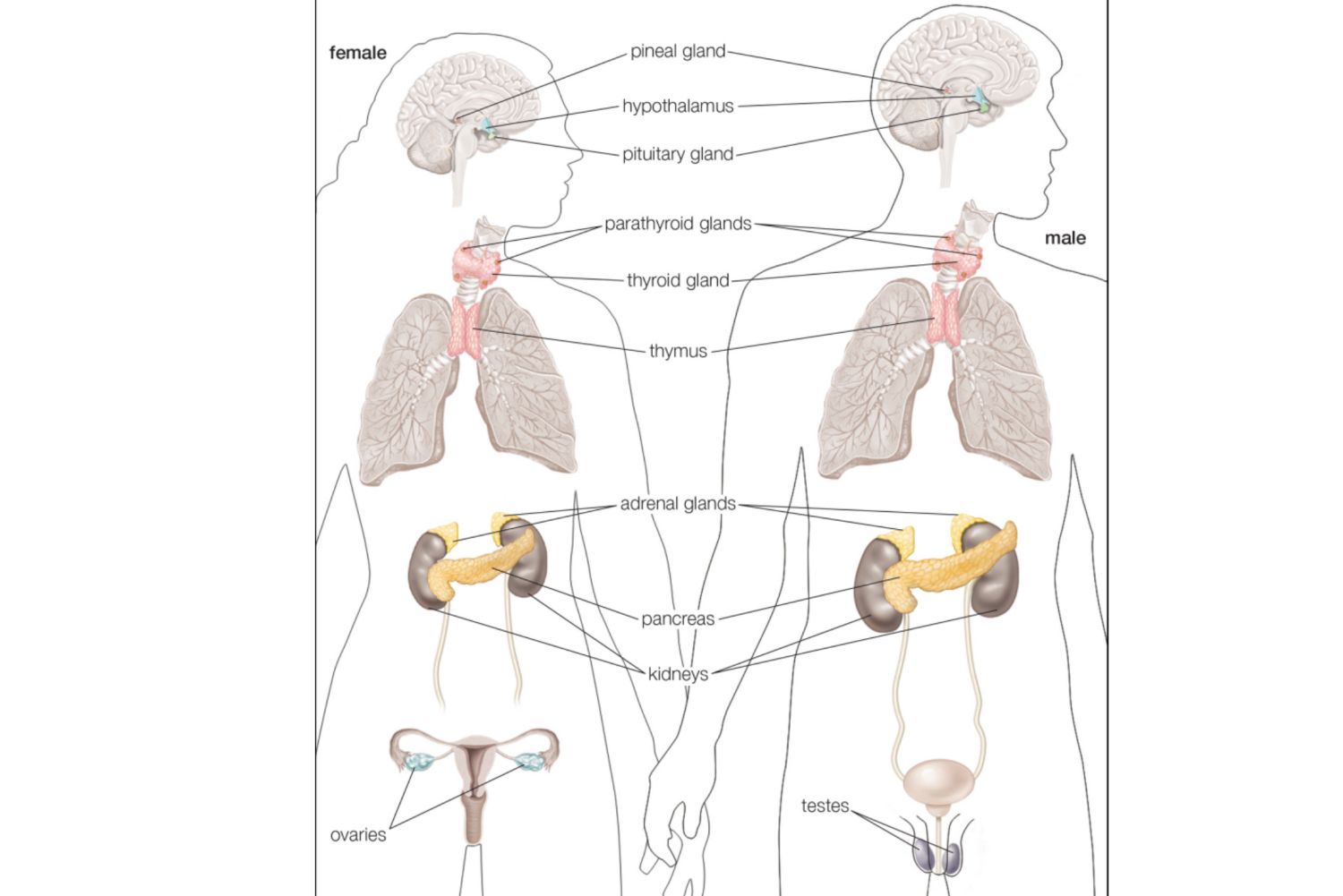
This is symbolized by the Greeks in the oracles, like the Oracle of Delphi. The symbol of the oracles is that they would sit in a cave over an opening in the Earth and vapors would rise to give them visions. That is just a symbol of sexual transmutation. Those vapors are the transmuted sexual energy that rise up the spinal column.
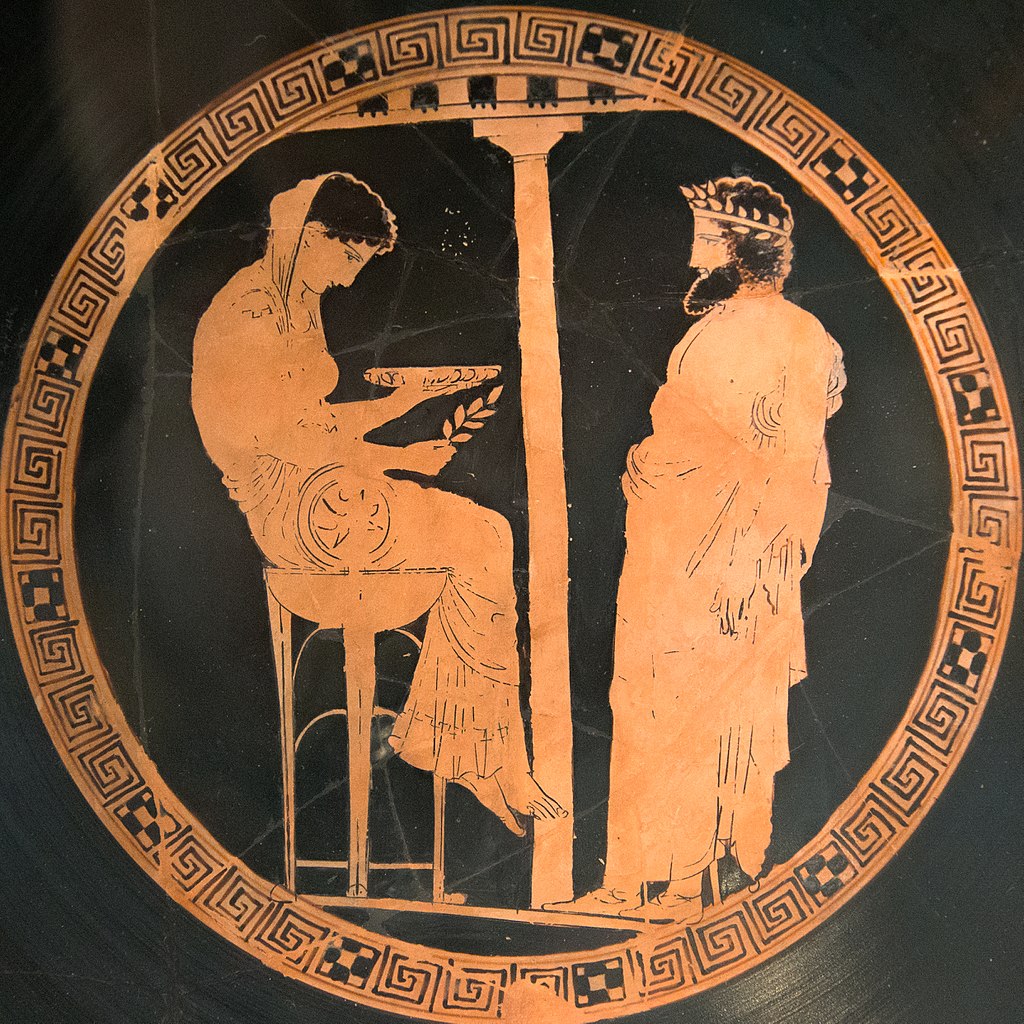
When in pranayama we breathe outward and direct that energy down to the heart, we influence the thymus gland and the heart. The heart, obviously, is the center of love, the organ of love and compassion.
If the sexual energy produces physical pleasure when it is expelled by the sexual organs, then if that same energy is retained and sent to the brain and heart, it will also produce bliss. However, in this case, the bliss is superior, because it is not corrupted by lust, but is instead directed by love, cognizance, expanded awareness.
So, that is how, through transmutation of that energy, you radically change chemistry in your body. You awaken and enliven the glands and the heart and the brain.
This is not just Buddhist or Hindu. All of this is in the Bible.
Jacob and the Stone
You may have heard the story in the Bible of Jacob’s ladder, when he saw visions of angels walking up and down a ladder, into heaven and back down again. In the scripture it says this:

“And Jacob rose up early in the morning, and took the stone that he had put for his pillows, and set it up for a pillar, and poured שמן shemen upon the top of it. And he called the name of that place Bethel (House of God)… And this stone, which I have set for a pillar, shall be God's house…” – Genesis 28:19-20
This symbol of Jacob raising a pillar and anointing it with oil happens after he has a vision of divinity, where God shows him a vision of all the angels in heaven. So, this symbol is showing how Jacob knew that the sexual stone, which is the sephirah Yesod, is the foundation stone of the temple. If you look at the Tree of Life you see it here. Yesod means “foundation.” The temple or house of God is founded on the stone. The temple or house of God is the Tree of Life, and as you see, it rests upon Yesod, the foundation stone. Remember, when the Tree of Life is placed over your body, Yesod corresponds to your sexual organs.
Solomon, the solar man, has to build a temple on the foundation. But if you know Christianity you know that the foundation stone is the one that is rejected by people. People nowadays interpret that to mean Jesus physically as a person, that people reject Jesus. But the real meaning is, people reject sexuality in religion. They do not want to hear about it.
So, this story of Jacob raising up the stone is a phallic symbol, a symbol of the spinal column, and a symbol of transmutation: he is preserving the sexual energy, pouring the oil, the transmuted energy on the stone, as an act of sacrifice and worship.
Most people interpret these kind of stories externally, physically, like it means that there is this place somewhere in the Middle East that is called Bethel, where Jacob was and he literally slept on a rock. It does not mean that. This is a story, a myth, that teaches us about ourselves, what we need to do in order to be developed spiritually. We know that is true because later in the Bible it says:
“Know ye not that ye are the temple of God, and the Spirit of God dwelleth in you?” - 1 Co 3:16
The temple is ourselves. We are the temple that must be built. Our foundation stone is sex. If we transmute the sexual energy, we can also receive visions as Jacob did.
Jacob raising the stone is exactly the same as the Greeks and their hermae.
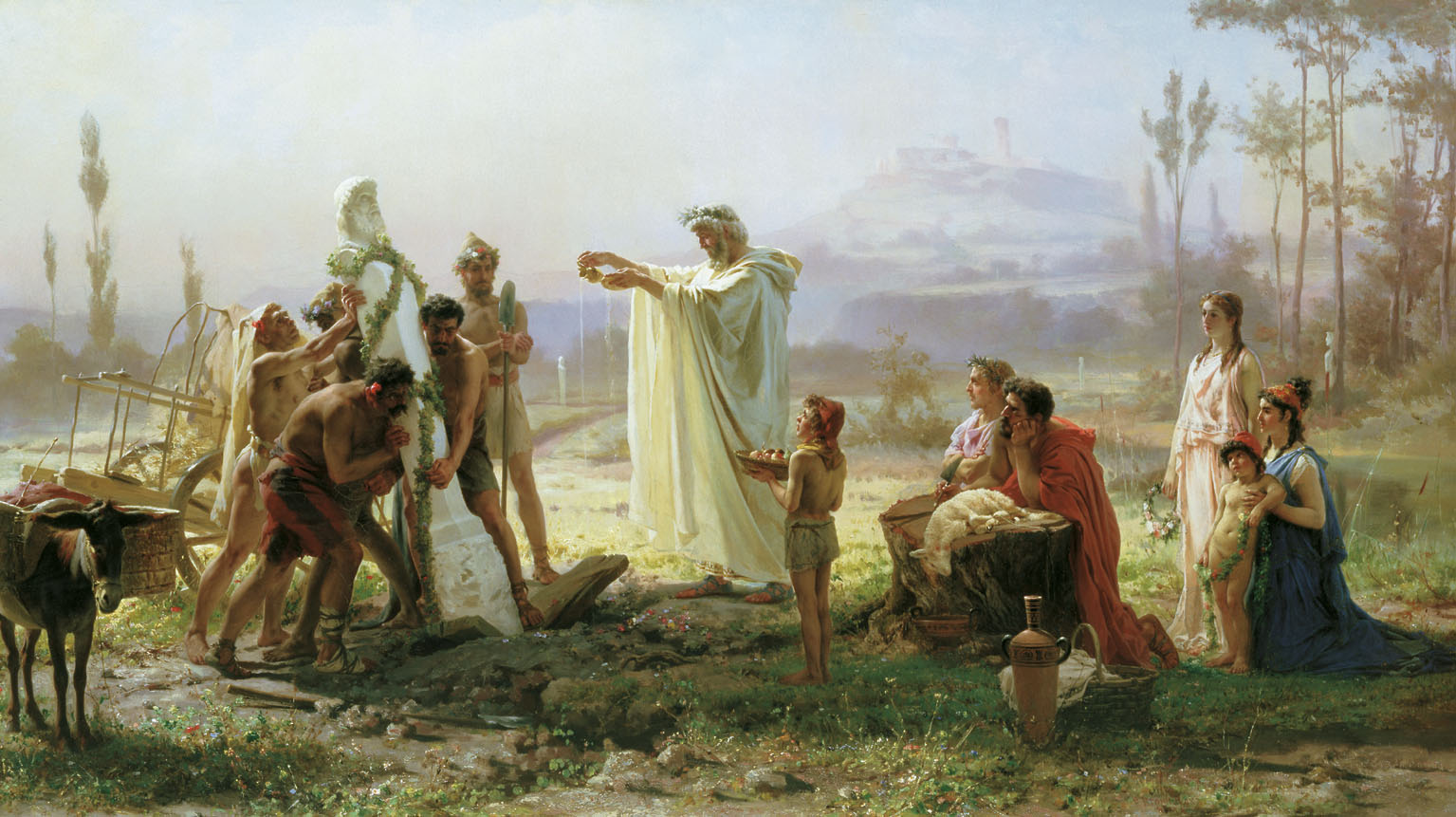
Most people nowadays have not heard of this. This painting shows a herm being raised at a crossroads, and in the ancient Greek religion that was a symbol of esotericism in a very profound way. In this particular painting it is a little bit obscured, but a herm was a stone pillar like the Egyptian djed, represented the spinal column that the energy rises up, and that the travelers would anoint with oil. They would pour oil on the top of it as a blessing, as a remembrance of divinity, as a request for help and protection. But what you do not see in this particular painting is that the herm always had a phallus prominently displayed, because it is a sexual symbol.
The ancient Greeks knew these mysteries. So, the symbols in the story of Jacob are not unique to the Bible.
And it is also the same as what is explained in the Tantras. Jacob blessing the stone, raising the semen, is the same as what is written here in the Chakrasamvara of Fundamental Tantra of Buddhism:
“To draw [bodhichitta] up the central channel [spinal column] means to draw up and stabilize at the crown focal point of energy the seminal essences that have flowed down to the tip of the secret place [sexual organ] by reversing them and experiencing the joys in the ascending order.” –Chakrasamvara Fundamental Tantra
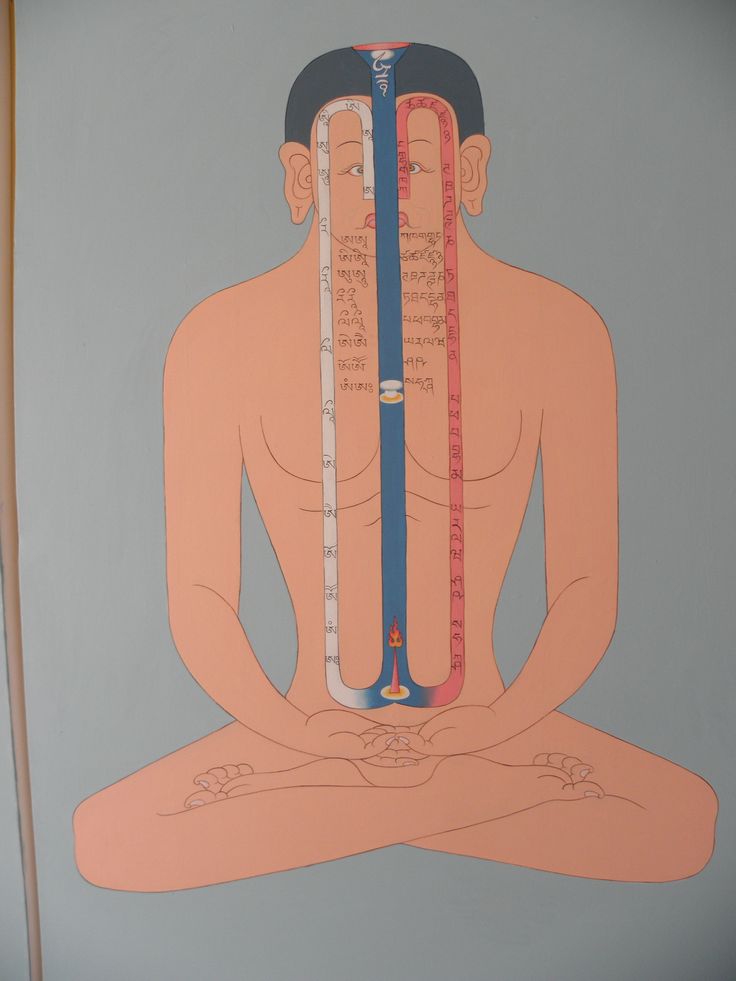
Conserve your sexual energy, raise it up the spinal column. It is the same teaching in Tantra, in Judaism, in Christianity and the Greek mysteries, in Hinduism. They are all the same. In Hinduism we find this:
‘Whether one be a man or a woman, by restraining the bindu, [sexual seed] that others discharge during cohabitation [via orgasm], one obtains success in the practice of Vajroli... Through practice, the bindu that others discharge is drawn upwards. One can restrain and preserve one’s own sexual matter. The yogi that can preserve the bindu thus overcomes death; death comes by discharging the bindu, and life is prolonged by its preservation.’ –Hatha Yoga Pradipika
All of these quotations from different scriptures and religions point at the exact same chemistry. Life, love, spiritual development, compassion, all are substances that emerge out of the preservation of the sexual energy.
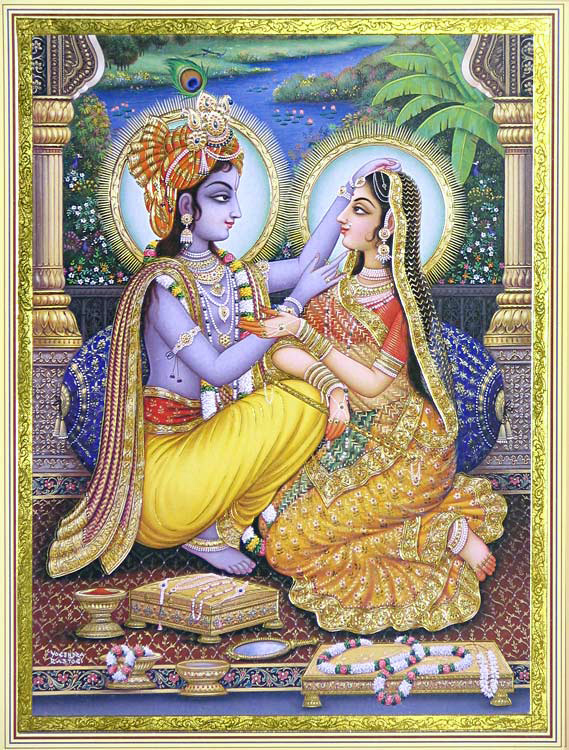
This painting shows Krishna and his wife Radha. Krishna is equivalent to Jesus: he is the savior, the solar divinity, an incarnation of Christ. In the greatest scripture of Hinduism, which is called the Bhagavad Gita, Krishna states very explicitly,
“I am kama [sexual love] that is not contradictory to dharma [religion].” —Krishna, Bhagavad Gita
That is why so many of the images of Krishna show him embracing his wife, loving his wife, sexually speaking, but retaining that energy, not wasting it. And that is the profound secret of Alchemy and Tantra.
So, whichever religion you study, you find the science hidden. It is in the Christian Bible too. In the Book of John, Jesus says,
‘...whosoever drinketh the water that I shall give him shall never thirst; but the water that I shall give him shall be in him a well of water springing up into everlasting life.’ - John 4:14
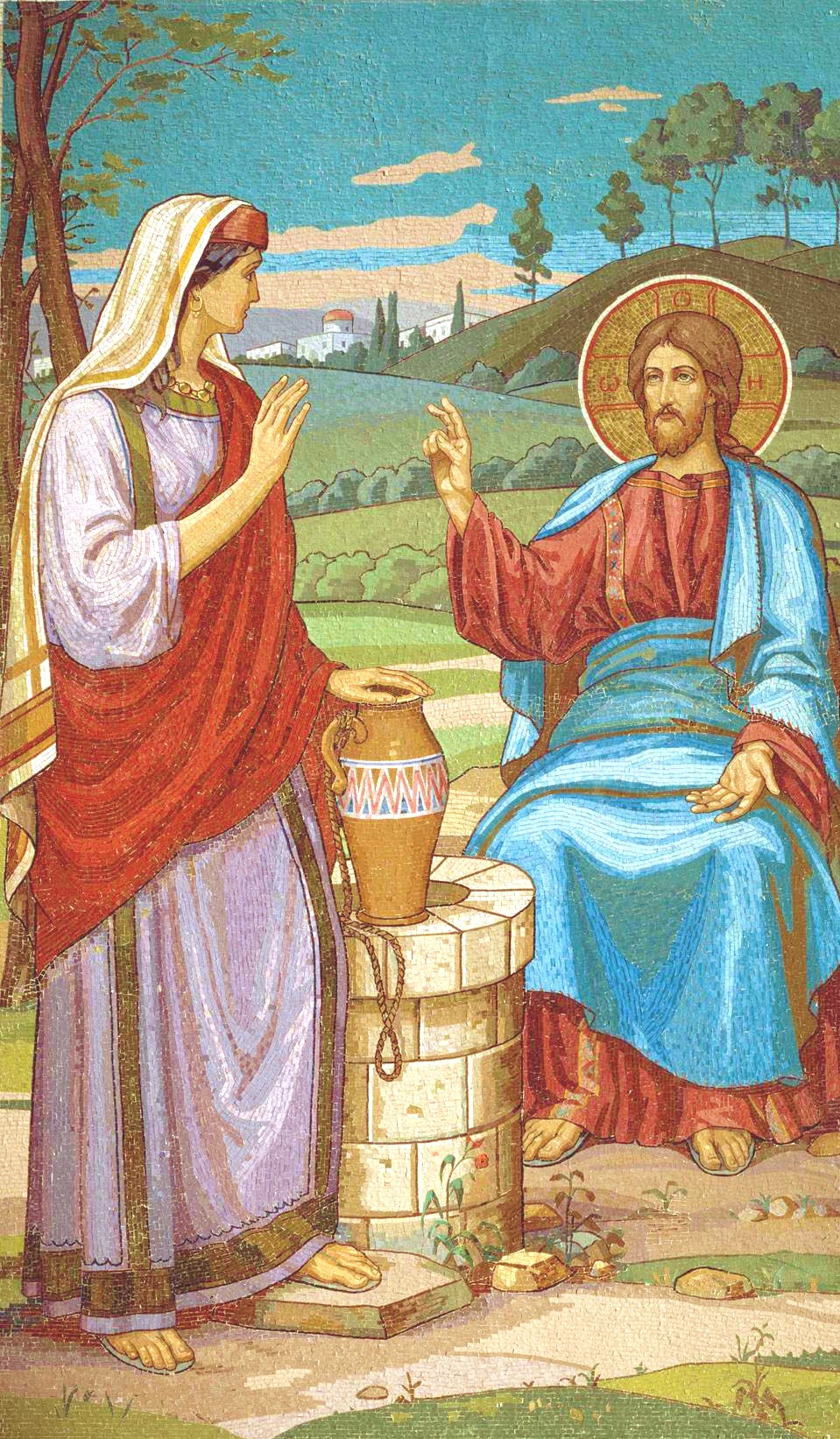
‘...out of his belly shall flow rivers of living water.’ - John 7:38
This is related with a few stories in the Book of John about the conservation of the sexual energy. That is why the letters of John says,
‘Whosoever is born [again] of God doth not commit sin; for his sperma [seed] remaineth in him: and he cannot sin, because he is born of God’. –1 John 3:9
We have talked about all those scriptures at length in other lectures.
The synthesis of all that is:
“The powers of the masters emanate from their purity of life [chastity] and the merits of their hearts. ” –Samael Aun Weor, Igneous Rose
Modern society does not realize that Jesus was married. Marriage is one of the great sacraments. It is the fifth of the seven sacraments in Christianity. But unfortunately, in the modern era, the spiritual, sexual nature of that has been forgotten. Jesus taught it, but they removed it from the Bible.

Now, let us get to the point.
Chemistry of Compassion
The word compassion in Hebrew is רחמים rachamim. This is a very profound word.
Hebrew is a very powerful language because every letter is also a symbol and a number. In their original form, the words have no vowels or spaces. So, there are different ways of taking meaning from the way the letters are organized.
The first three letters of רחמים rachamim are ר Resh, ח Chet, מ Mem. Together they spell רחם, the word for “womb, uterus” in Hebrew. The last three letters are מ Mem, י Yod, ם Mem. The letter Mem is our English M, and has two forms. If the letter Mem is at the end of a word, it has a different shape but it is the same letter. Mem, Yod, Mem spells מים, mayim, which is “waters.”
So, the word for compassion in Hebrew is composed of the feminine sexual organs and the waters.
How striking that is! Even the way the word is written in Hebrew reveals the origin of compassion: רחמים rachamim is made from מים + רחם ; it is born of the sexual waters in us.
The waters are a very profound symbol in all religions.
Just think for a moment what you do know of the Bible, for instance. How significant are the waters in the Bible? The waters are created in the very beginning. The waters are divided from the waters. There is Noah and the flood. There is Moses dividing the waters. There is Jesus walking on the waters. There is Jesus talking about the living waters that come out of our belly. The waters are a very significant symbol in Christianity and Judaism. But the waters are also very significant in the Asian traditions.
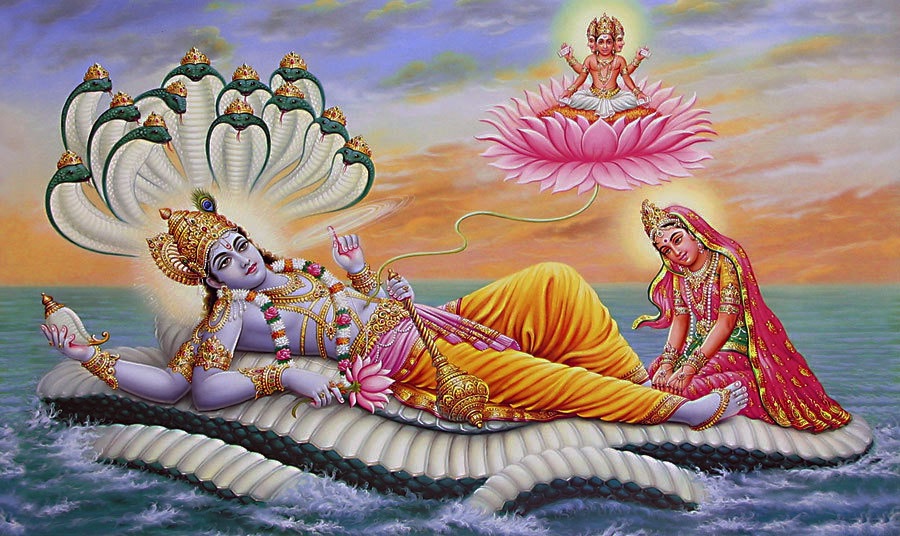
For instance, Vishnu and Lakshmi float upon the waters. It is one of their profound symbols. Vishnu is the equivalent of Chokmah [“wisdom”] on the Tree of Life. Vishnu emanates his avatars into the world in order to benefit humanity. So, out of compassion, he sends his representatives in order to help us. Krishna is an avatar of Vishnu. So, you can say Vishnu is Christ. The same symbol is found in Avalokiteshvara, also called Kwan Yin or Kwan Shi Yin, the same symbol in Chinese mysticism of an androgynous divinity that emerges out of compassion in order to help all beings, has a profound relationship with the waters. What you are seeing in all these symbols, the mother of Christ, Vishnu and Lakshmi, the one who sends the avatars, Christ figures, into the world, are all the same: compassion, Christ, love, sex. You cannot separate these because they depend on each other. These are very profound symbols with a lot hidden in them.
The Hebrew word רחמים rachamim, compassion, begins with the letter ר resh, which symbolizes your head.
The second letter, ח chet, symbolizes the union of Adam and Eve, male and female. In the Hebrew alphabet, ח chet is the eighth letter, and comes after ו vav (6) and ז zayin (7). Vav ו is masculine, zayin ז is feminine, and they look really similar to each other. They are almost identical. They represent Adam and Eve. When Adam and Eve, ו vav and ז zayin, unite, they form ח chet. The letter ח chet is the first letter of the word חי chai, which means ‘life’.
ו vav + ז zayin = ח chet = חי chai (life)
You see? Simple. Beautiful.
Vav and zayin united (Chet) represent these two channels of energy in your body which are symbolized on the caduceus of Mercury. If you have ever seen a Caduceus of Mercury from the Greek traditions... if you ever go to a doctor’s office, it is there. It is a central column with two serpents on the sides. Your spinal column is the center, and on the sides are a solar current (Adam, vav) and lunar current (Eve, zayin). All of that is Chet.
Then you have mayim, the waters. Where are the waters in you? There are two letters mem, and there are two waters. One is the waters of your sexual organs, where your seed is. You can call it ‘semen’ in Latin. Whether you are male or female, you have sexual waters in your sexual glands. But you also have, chemically speaking, almost an identical water, that your brain floats in. The waters in your sexual glands are nearly identical to the cephala rachis liquid that your brain floats in. And they are connected to each other by the spinal column. So, that is Mayim in you. The waters above, the letter Mem. The waters below, the letter Mem.

Between the letters mem is the letter י yod. Yod is the tenth letter of Hebrew, and the number ten. And as the tenth letter, it can relate with the physical body (the sephirah malkuth). But it can also relate with the sephirah Kether at the top of the Tree of Life.
The letter י yod represents the covenant between divinity and initiates on the path.
“And God spake unto Noah, and to his sons with him, saying, 'And I, behold, I establish my ברית (beryath, covenant) with you, and with your זרע (zera, semen) after you…” - Genesis 9:8-9
That little dot, י Yod, is the bindu [“dot”] of the Sanskrit language, which is widely used in Tantra to symbolize the sexual energy. It is the “jasmine-flower drop” of Tibetan Buddhism. It is the tenth letter, and the ten sephiroth condensed in your sexual energy. It is the ten laws of the commandments. It is the relationship between you and divinity. It is the energy in your sexual organs. It is between the waters.
That is why the waters are divided in the Bible, not just once. That division of waters is where we must separate purity from impurity. When Moses separates the waters, it is to cross to the other side to escape the Egyptians, to save the people of God, and when they cross, the waters destroy the Egyptians, who symbolize our egos, our defects.
All of that is symbolic, not historical. Moses in Hebrew is spelled Mem, Shin, Hei. Mem is the water, Shin is fire, Hei is the womb. His name literally means ‘born of water and fire’. Moses symbolizes our willpower. Consciousness. Moses on the Tree of Life is Tiphereth. Exactly in the middle. When he splits the waters, he is dividing the purity from the impurity so that the purity can be saved, and the defects can be destroyed. Moses is our willpower that does the work. The separation of the waters is this chemistry.
When you learn how to preserve the sexual energy, it requires willpower, thus you are gaining access to the powers of Moses. Willpower is the ability to radically transform yourself and take yourself out of suffering. The way to do that is to overcome desire. You have to kill all those Egyptians in yourself: defects, vices, errors, mistakes. That is why all heroes descend into the underworld in order to save their true love who is trapped there. They must slay the dragon, the monster, the minotaur, the medusa. All of those symbols mean the same thing. The weapons that they need are created precisely from the sexual energy.
If you are in a couple, learn to preserve and transmute. If you are single, learn pranayama.
"Single people must transmute the seminal liquor with deep breathing, keeping the lungs full thirty seconds or more. This svara [breathing] exercise must be performed daily." —Samael Aun Weor, The Mysteries of Life and Death
So, that is the end of the lecture. It you have questions, you may ask.
Questions and Answers
Audible: So, killing the desire is just a metaphor?
Instructor: No. It is literal. Desires are the cause of suffering. When we act on a desire, we are not seeing reality. We are seeing a short-term gain out of selfishness, something that we want for ourselves. In that type of desire, there is no compassion. There is just lust or anger or pride. When we act on that, the energy that is put in motion becomes trapped in that desire and it only wants to repeat that desire.
So, for instance, anger is the desire to repeat the suffering; when you get angry, you want someone else to suffer. It only wants to repeat pain. Lust is the same. It wants to repeat the same sensations repeatedly without recognition of the consequences of that action.
Pain and pleasure are a part of nature. Inherently, there is nothing wrong with them. They are part of how nature functions. The problem is in us: we have converted pleasure and pain into a playground; we do not care about consequences. That is why we suffer so much. It is because we have misunderstood how to use matter, energy and consciousness to rise out of suffering. Instead we are deepening suffering. That is why life is getting more and more complicated, more and more painful. more and more difficult, because we are not learning from our mistakes.
The purpose of learning meditation and sexual transmutation is to learn to use our energies on a daily basis to create benefit. Instead of creating suffering, we learn to adopt superior ways of acting and behaving. We learn to use sex in a positive way. We learn to use our intellect, heart, body, everything, in a higher way. In a better way. The guiding principle, rather than being desire and what ‘I’ want and ‘me, me, me’, becomes instead, ‘What is good for everyone? How do I act compassionately? How do I overcome my short-term self-interests and act on what is better for others? Better for my family? Better for my loved ones? Better for my neighbors? For my community? For my planet?
Simply put, we need to learn the ethics of the consciousness, which comes from divinity, within us. We need real ethics, not morals, but ethics based on knowledge of cause and effect.
Conscious ethics leads to superior actions. When a superior action is powered by superior energy, then the impact of that action is far greater. Jesus had an incredible impact on millions upon millions of people, because there was so much energy behind every action he performed. Similarly, when we start to harness more and more powerful forms of energy in ourselves, we put those to work in beneficial ways, the outcome is multiplied exponentially.
Audience: So, when you kill your desire, is that when you start to see that emptiness?
Instructor: You could put it that way. However, truly seeing the emptiness in things is something very profound, a kind of vision that only Turiyas have.
For us, we start towards that kind of sight by recognizing the fundamental illusions that our mind is constantly hypnotized by.
The idea is this: When you start this kind of work, the initial learning process takes time. You have to learn all this information and how to organize it into a practical way in your life. As you start practicing this teaching, you start to reflect upon your experience of things. So, when you have a certain experience during the day, and you meditate on that event, you reflect on it and you observe the facts of it. You are observing cause and effect. You are seeing, ‘Because I was thinking and feeling in this way, these were the outcomes, the consequences of that’. Following that step by step leads you to recognize that the way we perceive commonly is mistaken. We take for granted what we see and we think it is real in the way that we see it. And when you meditate and reflect on your experiences, you start to see, ‘I was not seeing reality at all. I was seeing my limited perception, my limited perspective. I was not seeing how other people saw it. I was not seeing what was really going on in that situation.’ Little by little, that expands further and further. Your insight starts to go deeper and deeper. Eventually you start to grasp that we are not seeing the fundamental reality of things, ever, because our consciousness is asleep, conditioned, and deluded. By extension, eventually, a person who is developing an expansion of perception will eventually perceive that at the base of all those circumstances is profound emptiness. Philosophically, this is hard to explain because it seems abstract, but it is not abstract in the process of meditation, and become something that is vibrantly real. This perception teachings you to not be identified with things. You start seeing success and failure as the same, praise and blame as the same; you are no longer identified with circumstances, but remain serene, aware. You perceive directly, without pain, but with understanding and serenity, that someone who loves you today might hate you tomorrow. Instead of reacting to that with fear, anger, or pride, you treat them with kindness, understanding, patience. The people that are your friends today could become your enemies tomorrow, and your enemies today could become your friends tomorrow. In that case, you learn to treat them each the same: you cannot differentiate, treating one better than another, because tomorrow they might reverse their positions. Your enemy today could become your husband or wife, because our karma is so complicated. Therefore, you rise out of personalism, favoritism, and start to generate a truly universal understanding, compassion, love.
Learning to see the emptiness in things is learning to see with a kind of indifference and a penetrating insight. This is to be the same person, acting the same way, all the time. In all circumstances, to be serene. In all circumstances, to remember divinity. In all circumstances, to be compassionate. In that way, all the flux and flow of our circumstances ceases to have such a powerful effect on us, and instead, we start to be the same person: connected, present, attentive, intuitive, compassionate.
Audience: How can you be compassionate yet be indifferent?
Instructor: It is difficult to grasp. By indifference we mean that we no longer seek personal desires. We respect the will of others. We respect the will of God. For instance, someone who is awakening positively knows that all of their circumstances are managed by divinity for their own good. Knowing that brings a profound acceptance of circumstances. That is what we mean by “indifference.” One become indifferent to wealth or poverty, fame or obscurity, praise or criticism. Your attention is on higher purposes, thus you are indifferent to impermanent, temporary circumstances.
If you think about Jesus, for example, when he was being tortured, he was exemplifying compassion towards his persecutors. When I say indifference, he was not trying to change his circumstances because he knew he had to go through that. It was part of his mission.
Now, that said, there are times when one must act. What I mean by indifference is to not be identified, not to become hypnotized and have an instinctive or automatic reaction to things. To be indifferent means to be cognizant. To be aware. One must always act, but act rightly. I do not want you to think indifference means that you should just sit back and let people kick you and knock you around. It does not mean that at all. You should not be complacent with crime. You should not sit back when someone is being harmed. You have to act to protect others. You have to act rightly in all circumstances when action is called for. Speak when words are necessary, and be silent when silence is necessary. That is to be compassionate in action. The indifference is to not take things personally and to not take things into pride or to react egotistically.
Audience: Is loving kindness like meditating, or [inaudible]?
Instructor: When we talk about bodhichitta in traditional Buddhism, bodhichitta has many treatises devoted to explaining its practical reality. To simplify, it is presented in two primary forms. There is aspirational bodhichitta and there is actual bodhichitta.
Aspirational bodhichitta or aspirational compassion is like having an attitude of loving kindness, to wish for the well-being of others. To develop this, people do practices like metabhavana or meta, which is to visualize people and send your love to them. This is good. Nothing wrong with that. Wonderful. It is a good training practice, but it does not develop actual bodhichitta, because if someone is wasting their sexual energy through the orgasm, they are throwing away the substance of bodhichitta. To develop actual bodhichitta you must be conserving bodhichitta.
If on the other hand someone is conserving the sexual energy and they are working on themselves psychologically to conquer pride, lust and envy, hat bodhichitta will naturally arise and become something spectacular in them. They do not have to do any “loving kindness practice” because bodhichitta will emerge automatically, naturally. When you destroy your pride, humility emerges naturally. When you destroy your anger, love emerges naturally. When you destroy lust, chastity, purity emerges naturally. Those are just the natural flowerings of that force.
Loving kindness is good. It is good to meditate on having love for others, but it is better to transmute the sexual energy and work practically with the substance of love to destroy the causes of suffering: our egos.
Audience: To achieve that is actually very difficult though, is it not?
Instructor: Yes! But what choice do we have? Either you clean your mind yourself or nature will do it in hell. And that is far more painful and difficult.
It is difficult to do the work ourselves because you have to conquer yourself. You have to conquer your own inner Medusa, the antithesis of the divine mother. Who is Medusa? She is the opposite of Aphrodite. Have you studied Greek mythology? Aphrodite is the beautiful goddess that everyone admires. Medusa thought she was better-looking than Aphrodite, so the gods punished Medusa and converted her into a devil. It symbolizes how that sexual energy, through lust, pride, vanity, becomes inverted. Medusa and Aphrodite are two sides of the same thing.
For us to experience real compassion, real love, we have to kill Medusa, who is inside of us. She is our lust. She is our pride. That is why she has all those snakes on her head: they are the egos in our mind. There is no coincidence that a serpent tempted Adam and Eve and that Medusa’s head is full of snakes.
We need to be the hero who is armed by the divine mother, like the images of the divine mother creating the Christ, to descend into the underworld in ourselves and to slay that devil, which is a difficult work. That is why this mystery is shown as a labyrinth. When Theseus is going after the minotaur, it is very tricky to slay that beast, but that is the work of liberation. If you want to come out of suffering, the cause of suffering has to be destroyed.
So, we have two options. We can do it ourselves. We can kill those desires, we can kill the devil, the dragon, the demon, all those symbols ourselves in the time that we have available to do it. And if we do not, nature will do it for us. But that is Hell. That is why Hell exists. So, the ones that do not do it themselves, nature recycles them. Takes a long time and is very painful. That is why religions are always saying ‘Do not fall into hell. Adopt religion and follow the belief system, etcetera, etcetera’ because they want us to come out of the hell realms.
Treasury of Knowledge says:
“If practitioners transgress pledges and do not restore them, the transgressions become the root cause for their fall into the hell of Unceasing Torture or another hell…”
This tantra is stating very explicitly: ‘Wasting the sexual energy is what causes people to go to Hell’. That is what the symbol of Adam and Eve means. Eating the forbidden fruit is having the orgasm. When you eat the forbidden fruit, you are cast out of Eden. Do you know what ‘Eden’ means in Hebrew? Bliss. Literally. Same symbol as Buddhism:
“...the seminal essence or sexual energy, is the embodiment of bliss [Eden], the ultimate [the Absolute].” — Hevajra Tantra
It is exactly the same teaching.
Audience: [inaudible]
Instructor: The heart conveys all the most subtle and most profound knowledge. It is not the physical brain. The heart is vastly more profound than the physical brain. What you may not realize is that your physical heart has tissues that are so sensitive, so delicate, that they can pick up the vibrations of an earthquake on the other side of the planet. In our condition, because we abused the body so rigorously in our lifetimes, we are always pounding it with intense sensations physically, emotionally, and intellectually that it becomes deadened, numbed. So, in the same way that someone who does labor, hard work, develop calluses on their feet or hands, your heart becomes callused. It loses its sensitivity. This is particularly true for those who abuse sex, or abuse their emotions, such as by being addicted to drama, intense music, drugs, etc. Additionally, someone who abuses the intellect a lot, who is a very intellectual person, underuse the heart so it becomes atrophied, like any organ that you do not use.
When we do feel a strong emotion, it can feel painful, because the heart is not being used regularly. It is in the same way that if you have not exercised in a couple years then you go to the gym and do a really intense workout, you are going to hurt because you did not use those muscles much. Your heart is just like that. When you do not use the heart in a daily way, in a way that it fully can be utilized, then you suddenly experience strong emotions, it hurts. It is painful, even if it is a positive emotion, it can hurt.
When you work with sexual energy in the positive way, to transform and utilize that energy in a positive way, a spiritual way, the heart becomes very strengthened and enlivened, and becomes softer, more elastic, more capable. It expands. It becomes richer. Your blood changes. Your brain changes. Your nervous system changes. All the glands in the endocrine system change and the pituitary and pineal glands expand and open up. Everything changes in you physiologically as well as psychologically.
In terms of the heart, it is the most profound tool that a meditator can use, because the heart is capable of knowledge that the intellect can never grasp. That is why it is so essential to do practices like the one we taught today where you are directing energy to the brain and the heart, to balance and nourish them.
